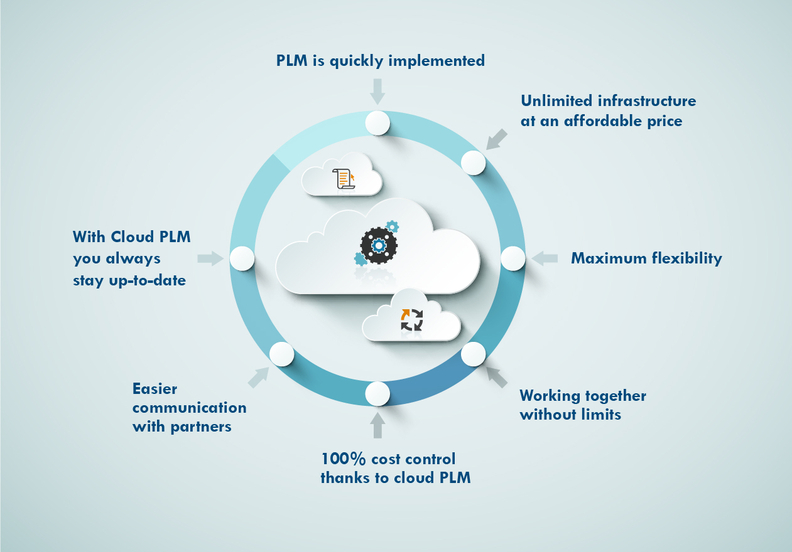Table of Contents
- PLM is implemented quickly in the cloud
- Unlimited infrastructure at an attractive price
- Maximum flexibility thanks to dynamic scalability
- Working together without limits - anytime, anywhere, on any device
- 100 % cost control thanks to Cloud PLM
- Easier communication with partner
- You're always up-to-date with Cloud PLM
- Conclusion
7 reasons to move PLM to the cloud
PLM has been used for decades in a wide variety of industries. But the erstwhile on-premise solution is being moved increasingly to the cloud. Even SMEs would do well not to miss the move to the cloud if they want to retain their power to innovate. After all, cloud PLM provides a whole host of competitive advantages. Here are 7 reasons why you should move your PLM to the cloud as soon as possible.
1. PLM is implemented quickly in the cloud
You have to admit that local PLM implementation can drag on and on. It is not uncommon for it to take many months to prepare and introduce a tailor-made solution, whereas a cloud solution can be fully implemented in the space of a few weeks, sometimes even within days. Once you have the relevant licences, you can get started straight away. At a speed that would never be achievable with your own rigid IT landscape.
2. Unlimited infrastructure at an attractive price
Product lifecycle management requires three things:
- Sufficient server capacity
- A lot of memory
- Continuous updating
Valuable resources that are not only expensive to maintain but that also take up a lot of your IT department's time. At least when the PLM infrastructure is provided locally. Cloud hosting takes all this away from you – and reduces ongoing IT costs to a fraction of the original amount.
3. Maximum flexibility thanks to dynamic scalability
In every company there are busy periods when you have to work to your absolute limit and maybe even take on new employees. When time becomes a particularly valuable resource, PLM solutions really come into their own. Additional licences can be booked at the click of a mouse – and are available immediately. Even server capacity can be easily increased.
What happens if business tails off again? Simply cancel those licences and servers that are no longer needed. This saves costs that you would have to continue to cover with an on-premise solution, at least in the medium term. In extreme cases (we all remember disrupted supply chains and even lockdowns), these costs could go so far as to pose a threat to the company's existence.
4. Working together without limits – anytime, anywhere, on any device
"New work models" are what determine today's world of work. In many industries, working from home, fuelled by the coronavirus pandemic, has become the new normal. PLM cloud solutions ensure that product information is available to absolutely all employees – whether they are working in the office, from home or on customers' premises. All data can be accessed and edited twenty-four seven, regardless of location or device. This is how PLM in the cloud will shape future working practices. Many of our CAD integrations also work with cloud-based PLM systems to facilitate cross-domain collaboration and thus bring new products to market on time and within budget.
5. 100% cost control thanks to Cloud PLM
The dynamic scalability of Cloud PLM not only ensures better planning capability but also protects you from unforeseeable costs that could make a deep hole in your budget, for example, as a result of sudden server failure and the associated repair costs. And disaster recovery is also generally guaranteed. On the one hand, data loss is unlikely due to the hosting provider's high levels of security, and on the other hand, the providers usually operate one or more backup servers that protect your data if the worst comes to the worst.
6. Easier communication with partners
Another practical feature is that, in cloud environments, platforms can be easily set up for communicating with third parties. If you want to share data on a temporary basis with customers or external partners, sharing appropriate access rights to important functions is usually straightforward. This can be either permanent or temporary.
7. You're always up-to-date with Cloud PLM
As with other software, PLM solutions are constantly evolving. With the latest version, you will not only ensure your competitive capability, but you will also be right up to the minute in terms of security. On site, however, software upgrades and the associated server modifications take up a lot of time. Whereas these are cost-intensive and often take many weeks to complete on site, in the cloud they run automatically in the background – usually with no additional cost.
Conclusion
For industrial companies – regardless of size – it is worth taking a look at cloud-based PLM solutions. Not only because of the reduced TCO compared to the on-premise version, but also because they help to bring new, customer-oriented products to the market faster and more cost-effectively. The management of mechatronic product data will also improve your teams’ interdisciplinary cooperation and help them to implement modified requirements with greater flexibility.
